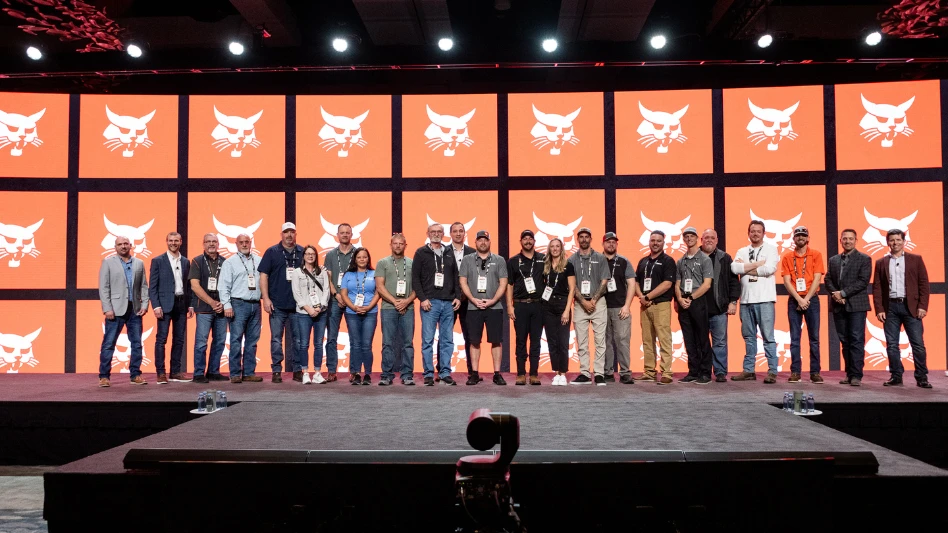Snow removal, sanding and/or salting work can be profitable – just don’t depend on the weather. If you don’t have a well-thought-out business plan and accurate pricing that minimizes risk while optimizing chances for increased profitability regardless of the weather, the biggest snow job you may face is a diluted profit and loss (P&L) statement that gives you a false sense of security.
THE SCENARIO. John owns a full-service landscape company. He wants to reevaluate his pricing structure for his winter snow removal and sanding work. The market for winter work is competitive. The going rate for sanding is $100 per cubic yard and $75 per hour for snow plowing with a 1-ton truck. However, John isn’t sure the $75-per-hour rate covers his crew’s drive time and 30 minutes of prep time before and after each storm. John has five drivers who plow snow. Three of the drivers also spread sand.
John’s crews will be paid an average of 10 hours per storm. Eight hours will be spent on site, plowing or sanding. The other two hours will include drive time from job to job and a minimal amount of prep time at the yard before and after each storm. The typical winter will have 10 storms, and three drivers will spend approximately five hours sanding per storm.
The average driver will be paid $15 per hour and will put in approximately 100 hours sanding and/or plowing. Sand mixed with salt costs $25 per cubic yard. Sales tax is 6 percent on materials. A driver can spread roughly 2 cubic yards of sand mix per hour, including load time, using a 1-ton truck. Labor burden is 25 percent. The overtime factor is zero.
The owner wants a risk factor of 20 percent included in the labor rate to offset any error in the average drive time estimated for the two scenarios and a minimum net profit of 20 percent on all winter work. G&A overhead costs for the year are $100,000. Billable field labor hours during the regular season total 10,000. Dividing the G&A overhead amount by the billable hours produces an overhead per hour (OPH) cost of $10. Even though all G&A overhead for the year is theoretically covered during the regular season, John wants to add $10 OPH to each hour of winter work.
He also wants to calculate a minimum curb-time rate for snow plowing and a per-cubic-yard rate for sanding. Most importantly, he wants to know if he can make any money at current market rates and how much winter work contributes toward his G&A overhead costs.
To price his winter work, John prepares a bid scenario for a typical storm for both plowing and sanding/salting.
PRICING SNOW REMOVAL WORK. John breaks the bidding process for snow removal work into three phases (see Chart No. 1 on page 150). The first phase contains the labor and equipment costs when the driver is on site plowing. The second phase contains the hookup and drive time for the truck and driver when both are not on site plowing. The total should equal the total of paid hours for a driver for the day. The third phase includes the margins and markups for the bid.
Phase 1 – Providing the Service. John increases the driver’s labor rate of $15 by the 20-percent risk factor to get a rate of $18. He then multiplies that by the eight hours of Phase 1 plowing time and enters it on his bid worksheet.
John’s 1-ton truck costs him $7 per hour to operate. He doubles this amount to cover the extra wear and tear winter work may cause. John then calculates his plow cost per hour (CPH) by dividing the purchase and lifetime maintenance costs ($4,000 plus 1,000 equals $5,000) by the projected lifetime billable hours for a plow (eight seasons times 80 billable hours per season equals 640 hours). He rounds the 640 to 650 and divides projected lifetime costs by this ($5,000 divided by 650 hours equals $7.69), which he rounds up to an $8 CPH. John then adds the doubled truck CPH to the plow CPH and multiplies this total by the Phase 1 equipment hours (eight hours times $22 equals $176). He enters the total on the bid worksheet.
Phase 2 – General Conditions. John calculates general conditions just as he did Phase 1 costs, but he doesn’t include the cost of the plow in the equipment calculations because it’s not being used or incurring wear and tear during general condition time.
Phase 3 – Margins and Markups. John multiplies his labor cost in Phases 1 and 2 by the 25-percent labor burden amount and enters it onto the bid worksheet. He multiplies the 10 labor hours in Phases 1 and 2 by the OPH of $10 to determine how much G&A overhead to add to the bid worksheet. He then totals all of these figures to determine the break-even point (BEP). Finally, John adds his desired 20-percent net profit margin to the BEP.
Dividing the total direct costs of $429 per day by the eight curb-time hours produces the direct costs per hour amount ($429 divided by eight equals $53.63). The BEP per hour is calculated by dividing the BEP total of $529 by the eight curb-time hours (equals $66.13). In other words, for John to cover all of his direct costs, he must bill at least $53.63 per curb-time hour. Any amount billed above $53.63 goes toward gross profit.
Snow Removal Conclusion. John can’t match the market rate of $75 per curb hour while maintaining both a 20-percent net product margin and two hours of non-billable general condition labor time per day. However, reducing general condition labor time to one hour (if possible) per day drops John’s rate to $73.44 ($661 divided by nine on-site or curb-time hours) while maintaining his goal of a 20-percent net profit margin.
Reducing net profit to 10 percent produces a rate of $73.50 ($588 divided by eight equals $73.50) without reducing general condition time. Reducing both net profit margin and general condition time to 10 percent and one hour, respectively, would allow John to drop his price to $65.33 ($588 divided by nine equals $65.33) if market conditions dictated.
John has one other option. He could possibly reduce his non-billable drive time to one hour if he could add five to 10 minutes of drive time to the bills for each of his customers if he’s billing on an hourly basis. Of course, customers should be aware of this practice prior to receiving their bills.
There are two important things for John to note from this exercise. The first is the impact non-billable time has on hourly curb-time rates. The second is that any billable amounts above direct costs contribute directly to the bottom line of the company at the end of the year. Therefore, it’s important for John to focus on his direct costs per day and per billable hour. These two numbers will provide him with easily targeted minimum billable amounts, ensuring that he covers all of his direct costs, no matter what the scenario.
PRICING SANDING/SALTING. John prices out his sanding work as outlined on Chart 2 (below). The sander cost per hour is $13. With a 20-percent net profit margin on top of all his costs, John must bill a minimum of $621 per driver per storm. This translates into a unit price of $77.58 per cubic yard, within the market price of $100 per cubic yard.
A more accurate GPM for sanding work at the market rate of $100 per cubic yard is 44.1 percent ([$800 minus $447 TDC] divided by $800 equals 44.1 percent). John could improve his GPM by increasing his production above his benchmark of 2 cubic yards per curb-time hour. Decreasing the general condition hours through better scheduling and/or more efficient loading would also increase the overall GPM on sanding work.
John could also increase his GPM by charging a minimum 1-cubic-yard amount (e.g. $100) for sanding on smaller jobs requiring less than 1 cubic yard of sand. By doing so and by “stacking” these jobs back to back, John could bill up to $200 to $300 per curb-time hour. The GPM on this type of work could surpass the 44.1 percent figure by another 10 to 20 percent.
Sanding/Salting Conclusion. The key is for John to bill a minimum of $200 per curb-time hour (when drivers are sanding) and a minimum of $800 per storm per driver. Meeting these criteria ensures they make money.
To answer John’s initial questions, his winter work is profitable, sanding being at the top of the list. But John must keep in mind that with winter work the market sets the prices. He has to be able to play the market’s game and win. He must understand his numbers and how drive time and prep time, as well as scheduling and establishing minimum prices and targeted minimum hourly and daily billable dollar amounts, can affect his profitability.
John’s question regarding the winter work contribution to G&A overhead costs can also be answered. Included in John’s winter prices is $10 for each labor hour drivers are paid. The total hours paid to drivers is 500 (five drivers times 10 storms times 10 hours per storm). We obtain the amount of G&A overhead costs included in the winter billings by multiplying the 500 hours by the $10 OPH equals $5,000. Winter work contributes $5,000 toward G&A overhead costs.
OTHER CONSIDERATIONS.
P&L Statement. In order for John to monitor the profitability of winter work, the company P&L statement should identify the sales and direct costs for both snow removal and sanding. Preferably, winter work should be its own division with its own P&L statement. This helps identify its GPM.
Company P&L statements become diluted if winter work isn’t separated from work performed during the regular season. Because winter work can often realize a GPM of 50 to 60 percent, it will distort figures and profit margins for other divisions. Once any type of work comprises more than 20 percent of total company sales, it’s wise to separate it from other work by means of its own P&L statement.
Contracts – Residential. Residential plowing is usually done on a per-push basis. The best way to ensure you’re pricing correctly and making money is to prepare a scenario analysis using your costs and production numbers. Be sure to include the net profit you desire. After each storm, you should enter your actual costs, hours and revenue into the scenario format to see how much money you made.
Contracts – Commercial. Commercial plowing and sanding is quite another story. One contractor billed his commercial accounts strictly on a per-push basis. The other had a fixed monthly billing amount for the four months of December through March. The total of the monthly billings covered a five-year average for the amount of inches of snowfall for the winter. Anything over the average was billed out on a time and materials basis at the end of April. To make this type of contract more appealing, the contractor would plow up to 10 inches above the average at no charge. I call this a fixed/variable or “flex” contract.
In the mid-1990s, the East Coast went through a five-year period of record snowfall, followed by a year of almost no snow at all, and then another record year. The contractor with the flex contracts was happy. His revenue reflected the change in snowfall from year to year. Most importantly, he covered his costs during the year when there was almost no snow at all. His clients were also happy because they had set budget numbers to deal with. While they didn’t like the extra billing in the record snowfall year, they did get a price break.
The contractor on a strictly per-push basis couldn’t win. One year he’d have minimal revenue, which didn’t even cover his costs to have the equipment and labor standing by. He wasn’t happy, but his clients were. The following year he had record revenue amounts. He was happy, but his clients weren’t.
At the end of one of the record snowfall years, he charged one of his “best” clients $80,000 for one storm at the end of March. The client had already been charged for more than his budget allowed. The $80,000 bill, while legitimate according to the per-push contract, was the straw that broke the camel’s back. The client only paid $40,000 and told the contractor to sue if he wanted more. No one was happy at the end of that season.
Winter work can be profitable, but it can cause a lot of trouble if you don’t manage both your risk and your client’s risk properly. Setting revenue goals for snow events and job costing each storm afterward will help ensure that you’re not the one getting snowed.
EDITOR’S NOTE: The costs used in our scenarios are for illustration purposes only. Your costs will vary. Build your typical one-day scenario. If your costing structure is accurate, the rates you calculate should be close to your current ones and to those general seen in your market.
The author is president of J.R. Huston Enterprises, a Denver, Colo.-based consulting firm. Reach him at 800-451-5588, jhuston@jrhuston.biz or via www.jrhuston.biz. You can buy his book, “How to Price Landscape & Irrigation Projects,” in hard cover or audio versions for $150 each at www.lawnandlandscape.com/store.

Explore the May 2007 Issue
Check out more from this issue and find your next story to read.
Latest from Lawn & Landscape
- Coxreels expands V-100 Series product line
- Landscape Workshop expands with 2 acquisitions
- Wilson360 adds Daniel Grange as new consultant
- Batman and business
- CH Products releases new tree stabilizer
- Savannah Bananas founder Jesse Cole to speak at Equip Exposition
- Catch up on last year's Benchmarking report
- Davey Tree promotes Kevin Marks as VP of Western operations







